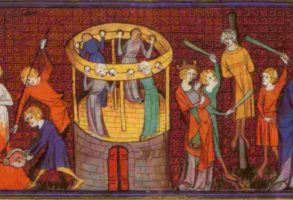Published October 2, 2015
Review:
MY DEAR BB . . .
Edited by Robert Cumming
Yale, 583 pages, $45
In September 1925, the future art historian Kenneth Clark, then 22, met Bernard Berenson, the eminent connoisseur, then 60. Clark was visiting Poggio Gherardo, the Florentine home of Janet Ross, a formidable Victorian character (Clark called her a “well-known terrifier”) who in her youth knew Dickens and Thackeray.
She took him to I Tatti, the beautiful villa owned by her friend Berenson. After lunch, Berenson told Clark: “I’m very impulsive, my dear boy, and I have only known you for a few minutes, but I would like you to come and work with me to help me prepare a new edition of my Florentine Drawings.”
Clark was stunned by the surprise offer. “It was,” he later recalled, “the most golden egg that the world of art had to offer, and I would be a goose to refuse it,” although, as he wrote to Berenson at the time, his parents were “very strongly opposed to my working in Florence & giving up all thought of a business or political career for the, to them, narrower field of art.” They later relented.
For the next three decades, Berenson (1865-1959) and Clark (1903-1983) exchanged hundreds of letters. These, along with others by Clark’s wife, Jane, and Berenson’s wife, Mary, are collected in “My Dear BB . . . ,” edited by Robert Cumming, an adjunct professor at Boston University. Divided into chronological sections, each prefaced with a helpful introductory essay about the period, the letters touch on many topics: friendship, travel, books, health, work and people. But art and attribution are the primary subjects. Clark is a master letter writer, Berenson less so.
In age, background, social standing and temperament, Clark and Berenson were as opposite as chalk and cheese. Berenson was the son of a poor Jewish family that immigrated to Boston in 1875. To rise in often anti-Semitic Brahmin Boston, Berenson shed his religion and humble past. A bright student, he went to Boston Latin School and then on to Harvard. After graduation he traveled throughout Italy studying paintings in museums, churches and private collections. Using his extraordinary visual memory, he was able to identify the essential stylistic characteristics of artists and compile accurate lists of their works. The lists, published in four volumes from 1894 to 1907, cover the major schools of Italian Renaissance painting and are preceded by introductory essays embodying Berenson’s principles of connoisseurship.
Remarkable for their breadth and accuracy, the books furnished the foundation for subsequent scholarship on Italian Renaissance painting. The “Four Gospels,” as the lists were sometimes called, made Berenson the high priest of attributions. Dealers sought, and feared, his judgment of their wares because the difference between a Basaiti and a Bellini meant big money. Berenson’s groundbreaking work in connoisseurship was finished by the time he met Clark in 1925, but he could still make or break the careers of fledgling scholars and critics.
Bright, talented and born to considerable position and wealth (his family made its fortune by perfecting the wooden thread spool), the posh and diffident Clark was just the sort of gilded young man that the snobbish Berenson was eager to advance.
And advance Clark did. In 1929, with almost no experience, he was asked to catalog the Leonardo da Vinci drawings at Windsor Castle. This was followed in 1931 by an appointment as Keeper of Fine Art at Oxford’s Ashmolean Museum.
Berenson thought Clark could “do better” by “getting away from the newspaperial attitude toward art.” He could, Berenson suggested, become “a student of art as a realm, of being with a formative influence upon the humanization of that fascinating biped man.”
In 1933, Clark was able to do just that when he got the biggest, most glittering museum prize of them all: the directorship of London’s National Gallery. After his appointment, Clark and his wife became stars of London high society. Jane, whose letters are the most gossipy and lively in Mr. Cumming’s edition, writes in 1939 about a luncheon they held for King George VI and Queen Elizabeth. The king, Jane says, “would not be interesting unless he were King.” The queen, whom she thought charming, “enjoyed the pictures especially oddly enough, the late blue Cezannes.” The following day the Clarks had lunch with Neville Chamberlain, where they “drank very good hock” from Germany.
But Clark was more than a social celebrity and a successful museum administrator. He was a superb critic who from his first books, a groundbreaking study of the Gothic Revival and a masterly monograph on Leonardo, produced a stream of volumes, articles and lectures that in themselves are works of literary art.
In these publications, he moved steadily away from Berenson’s focus on style toward a broader, more comprehensive vision of art in its historical and intellectual contexts. “The Nude” (1956), a brilliant example of this approach, found favor with Berenson, and not just because the book is dedicated to him. He says that it goes “beyond expectation” and that it unfurls the “subject to its vastest horizons” and fills “it with details so perfectly communicated . . . that it is a delight to read and read and read.”
Surprisingly, the patrician Clark was a great believer in the popularization of art; he is best remembered for “Civilization” (1969), his hit TV series. The highbrow Berenson was much more of an elitist who was uninterested in a large lay audience.
But no matter how far he strayed from Berenson, Clark never forgot what he owed the older man. This gratitude is seen throughout their correspondence but never more clearly, and poignantly, than in a birthday wish Clark sent to Berenson in 1955, 30 years after they first met at I Tatti.
His first and greatest debt to Berenson, he says, “is emancipation from the various intellectual fashions of the time.” Clark adds that if he had never gone to I Tatti, “I should certainly have been bound apprentice to Bloomsbury—or perhaps never moved beyond Oxford.” After meeting Berenson, Clark writes, his children told him that “they have discovered the origin of this or that turn of thought or behaviour which I had supposed to be my own. In all these ways I am truly your son.”
“My Dear BB . . .” has a several defects. Most of the hundreds of footnotes that Mr. Cumming appends are helpful, but many are stuffed with extraneous detail. He also states, puzzlingly, that the letters are “edited” but gives no explanation as to precisely how. Finally, while the correspondence is often entertaining and instructive, one has to question how much it adds to our understandings of Berenson and Clark beyond the already published biographies of both men and the three previous collections of Berenson’s letters.
Today both Berenson and Clark are largely ignored. Their work sprang from a close observation of style, an approach that is seen as hopelessly outdated in the contemporary art historical world, which focuses on art as social documentation. As an antidote to all of this, read Clark’s insightful, gracefully written books—“Leonardo da Vinci,” “The Romantic Rebellion” or the companion book to “Civilization,” which sold over a million copies—or Berenson’s gimlet-eyed introductory essays to “The Italian Painters of the Renaissance.” For a deeper understanding of the two men than that found in Mr. Cumming’s edition, see Clark’s wonderful, self-effacing autobiography or Berenson’s more troubled and darker diaries and “Sketch for a Self-Portrait,” written when he was in his 80s. Most of these books are long out of print, but for the general reader searching for incisive, illuminating writing, they’re well worth the effort.
—Mr. Cole, a former chairman of the National Endowment for the Humanities, is a senior fellow at the Ethics and Public Policy Center.





